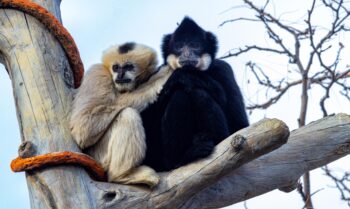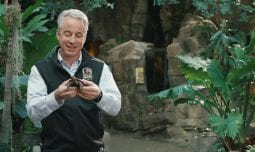January 29, 2019
7 Questions with Bert Vescolani
Denver Zoo’s New President/CEO Offers His Outlook for the Future of the Zoo
Bert Vescolani is only a few months into his new role as Denver Zoo’s president/CEO, but he already has some big plans. We sat down with him to find out why he thinks zoos are so important, and what changes you can expect to see from Denver Zoo in the near future, both within our gates and beyond.
What most excites you about working at Denver Zoo?
Each day, I walk around the Zoo so I can watch our guests connect with animals they will likely never have the chance to see in the wild. Seeing their excitement and knowing they’ll walk away from the Zoo with a greater appreciation and love for wildlife is the most fulfilling part of the job for me and, I believe, our staff and volunteers.
Why are zoos so important from your perspective?
We know from multiple studies that when kids have safe, engaging experiences with animals their appreciation for wildlife goes up. But there is such a high proportion of kids that have never had those opportunities or the chance to connect with animals in the wild. We have multiple generations of children that are afraid to go outside in places that aren’t manicured lawns and playgrounds. And that scares me, both as a parent and educator. Zoos offer a chance to connect those kids to the natural world in some very positive ways.
What’s your vision for the Zoo?
My vision is find new ways to connect people with wildlife and wild places. That has been at the core of who we are and what we do for more than 120 years, but our approach has changed significantly. Old zoos displayed animals in a menagerie style, whereas today’s zoos are integrated ecosystems that are wholly dedicated to animal welfare, conservation and creating awe-inspiring experiences for guests. As I think towards the future, I start with a few questions: How can we create the most enjoyable experiences for guests? How can we be the catalyst for change that allows for people and wildlife to live symbiotically? How do we build and improve habitats for our animals that allow them to live happily and provide our guests with the best possible experience? How can we, as humans, be the species that helps?
What big changes can guests expect to see soon?
Our immediate focus is on animal care and husbandry, improving guest experience and repairing aging infrastructure. The first big change you’ll see is construction on a new, state-of-the-industry animal hospital, which will start in just a couple weeks. Once complete, it will enable us to provide even better medical care for our animals through a combination of modernized tools and enhanced facilities. We’re also in the process of renovating the former polar exhibit into a new, improved habitat for our two rescued grizzly bears, and a unique, two-fold learning experience for guests. On one hand, visitors will learn about bears in the wild, and on the other they’ll learn about bears in their own backyards and how we can coexist. This will be one of the first exhibits where we’re going to try this kind of “pilot” approach to storytelling around conservation and what’s most familiar to people.
And in the long run?
Over the next few years, we will be updating and improving the exhibits from the west side of Predator Ridge all the way down to the train and carousel. We’re going to create more of an African plains approach and combine species together where it makes sense to create a more immersive feel. At the same time, the team will be working on executing the Master Plan and garnering the financial support needed to build and maintain these incredible new experiences.
What role do zoos play in conservation? Is anything going to change about how Denver Zoo approaches conservation?
If you’re a pessimist, the future is bleak for wildlife. If you’re an optimist like me, you get excited about the role zoos play in helping bring the discussion forward and thinking about how we can all make a difference. Denver Zoo already contributes more than $2.5 million each year to manage five core field conservation programs around the world, including right here in the Rocky Mountain/Great Plains region. I want to increase our local conservation impact by putting our resources where they will be most effective, and continuing to partner with other like-minded conservation organizations.
What does success look like going forward?
The first—and most important—is making sure we’re providing the best possible care for our animals. We know when we’re doing it right because they exhibit the behaviors related to their natural history, and are indicative of comfort and wellness in their environments. The second piece is our impact from a conservation and education perspective—knowing that we’re moving the needle on impressions, feeling and actions related to conservation. Finally, success means we continue to be a strong resource for the community, both as contributor to the quality of life in the region, and as a supporter of the things that are outside of our gates.
-
 April 15, 2024
April 15, 2024Good Luck, Chuck!
Good Luck, Chuck! Beloved Bachelor Relocating as Part of Asian Elephant Species Survival Plan In a heartfelt and collaborative…
-
 April 15, 2024
April 15, 2024African Impact
African Impact Two New African Field Conservation ProgramsAim to Protect Gorillas + Grey Crowned Cranes We're honored to provide…
-
 March 1, 2024
March 1, 2024Last Place(s) on Earth
Last Place(s) on Earth New Asian Field Conservation Programs Protect Asian Elephants, Sumatran Orangutans + more Indonesia's Leuser Ecosystem…



